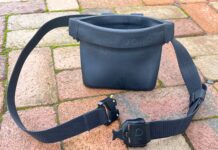The Arctic weather plaguing much of the country wreaks havoc with our dogs, too. Paws get frozen quickly in temperatures like these. Snow between your dog’s foot pads can cause frostbite and lameness, and crusted snow and ice can easily cut his feet. Trim the excess hair from the footpads and toes of longhaired dogs; this will make it easier to remove ice and snow.
Better yet, use booties for the best foot protection. Don’t be disappointed if your dog high-steps around in protest when you put them on; most dogs resist booties at first, but they typically quickly desensitize to the footwear when a fun outing is on the horizon. A variety of windproof and waterproof coats for your dog are available on the market and worth looking into if your dog has a very short coat, doesn’t do well in cold temperatures, or you plan on making frequent stops during your outing.
Your local pet supply store may have cold-weather gear for dogs – and if they have good stuff, bless their hearts. It’s far more common to see “dress up” booties that are supposed to be cute but are useless in real world conditions. Active canine winter gear found on skijoring or mushing websites or outlets that specialize in equipment for human-canine athletic teams who participate in winter sports is the best bet. Their equipment is usually field-tested in severe conditions – a good testimony to the durability and function of the products.
Due to the fringe nature of most of these sports, most companies that sell such specialized equipment are small businesses owned and operated by enthusiasts of these sports; these folks tend to welcome interest in the products they offer and will be incredibly helpful in guiding you to what you need. A few good sites to explore include:
skijornow.com
scandiakicksled.com
sleddogcentral.com
ruffwear.com
Various companies gauge their boot sizes differently. Some measure from the heel of the pad to the tip of the toe, others include the toenail length in the size (probably a more appropriate measure, since not accounting for the nail could put excess pressure on the toes). A few brands measure size by the dog’s weight – in our opinion, an inaccurate system of measurement, since a dog’s weight can vary although his foot size does not.
Anyone who has ever struggled to put shoes on a baby (it’s pointless, but fashionable!) will immediately understand the challenge inherent in putting boots on dogs: They don’t have a clue that a little pushing down movement with their feet would make your job a million times easier. Fortunately, with a little practice, you get better at getting the boots on quickly. Just watch out for those dewclaws, if your dog has them.
Dogs are unaccustomed to having something attached to their feet, so don’t be alarmed if your canine pal acts like his legs are broken when you first try his boots on him. It can be amusing to watch your dog try to walk without putting his feet down. One of our dogs tried to take several steps while holding both hind legs off the ground. (It didn’t work.)
Your dog should quickly adapt to the strangeness of shoes on his feet and begin to walk normally again. Be sure to administer plenty of treats when you put boots on paws so your dog learns to happily anticipate their application. If he always wears his boots when he goes for a hike, they will become a reliable predictor of great times, and he will get as excited about seeing them in your hand as he does his leash.
When you first go out with boots on your dog, keep him with you on leash. You may have to readjust the boot straps a couple of times until you get them snug enough to stay on. If Ranger loses a boot when he is deep in the woods you’re not likely to find it again!
Note: Dogs cool themselves by perspiring through their pads. If you are using boots in warm weather, be sure to take breaks and remove the boots from time to time to prevent overheating.





